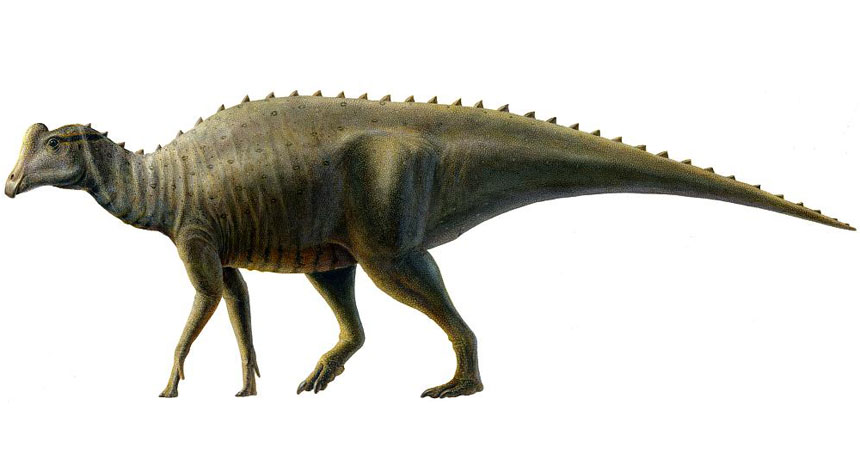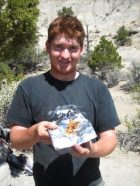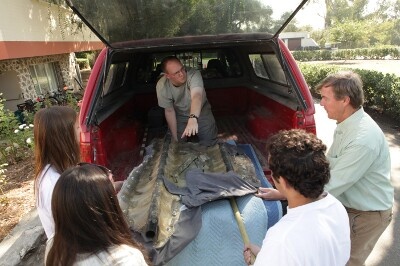High school student finds baby dino
Hadrosaur fossil is one of the most complete specimens found

This illustration shows a baby Parasaurolophus, a dinosaur called a hadrosaur that lived in what is now western North America 75 million years ago.
© Lukas Panzarin
Turns out you don’t have to be a professor to make a big finding. In this case, a high school student found one big discovery indeed. A baby dinosaur.
A few years ago, Kevin Terris was out prospecting with fellow students in Utah as a high school student. He was a student the Webb Schools, one of the only schools where there is a Museum of Paleontology on campus. The school gives its students many opportunities to do their own research, and in this case, their own digging.

On this dig, Kevin was with a group looking through areas in Grand Staircase-Escalante National Monument where fossils might be found. It was the second to last day of prospecting, and Kevin saw something sticking out of the ground under a rock. He called over the scientist leading the expedition, Andy Farke, to look. They decided to pass it by. But when they got to the other side of the rocky outcrop, they began to realize what they were dealing with. A skull. The bits they’d passed before? Toes.
It was an exciting moment. “I found a few things beforehand, but nothing quite this big,” Kevin says. “When I saw Dr. Farke getting excited, that was a good indicator that I should be too!” Over the next few years, the fossil was taken by helicopter back to California, where students from the Webb School and scientists from the Alf Museum of Paleontology carefully studied what turned out to be a baby dinosaur. “As exciting as it was, it was very time-consuming process, and [needed] a lot of patience,” Kevin says, “but definitely worth it.” Now the final skeleton, with analysis and artistic drawings of what it may have looked like, is available for free on PeerJ, a scientific journal.
The dinosaur in question, a young Parasaurolophus (pronounced PAIR-uh-SORE-AH-luf-us) nicknamed “Joe,” is the most complete fossil ever found of a hadrosaur. Hadrosaurs were duck billed dinosaur that roamed Utah during the Cretaceous period 75 million years ago. At that time, Utah was not the desert it is today. Instead, says Farke, it was more like “the Everglades in Florida. Very warm, very humid, lush vegetation, [it was] ocean-front property. ”
So baby Joe had some nice plants to munch as he grew, and Joe probably ate a lot. Born at roughly the size of a human baby, Joe was already six feet long by the time he died. Had he survived to become an adult, he would have reached 25 feet long. Baby Joe also would have developed the iconic hadrosaur crest, a long tube on the top of the head, connected to the nose and mouth, that scientists believe was used to make long, loud noises to signal to other hadrosaurs. Since Baby Joe just has a little bump, as opposed to the long complex tube of the adult, Farke believes that the sound would have been more like “a very high pitched honk.”

Such a complete skeleton gives us a lot of clues about baby dinosaurs, what they looked like and how fast they grew. But it turns out there was even more to the fossil. The scientists also found imprints of skin, showing that this dinosaur was of the scaly variety. And best of all, the fossil contains the imprint of a beak. The beaks of hadrosaurs were not made of bone. Instead, they were made of keratin, the same protein that makes up your fingernails and hair, which Farke notes is “is very rarely discovered.” And the results are exciting. It turns out that the beak of the hadrosaur extended much further than you would be able to guess from just the bones. So not only is this the most complete skeleton ever found, it may change the way we see hadrosaurs, giving them a bit of a nose job. Or maybe, instead, a beak job.
By putting the paper in a scientific journal where anyone can see all the data for free, Farke hopes that other students may be able to use this finding to make their own conclusions about Baby Joe. Farke is very proud of the high school students who helped with the work, three of whom — Derek J. Chok, Brandon Scolieri, and Annisa Herrero — are authors on the paper. He hopes that other students may be able to contribute. Paleontology, he says, is “a field where anyone can make a really important contribution. What I really hope is that some of the ambitious students out there will be able to do their own [work] with [the data].”
And what about Kevin, the student who found the skeleton? He’s gone on to college at Montana State University, and is majoring in … paleontology.
Power Words
Cretaceous The era of Earth’s history from 145 million years ago to 66 million years ago.
fossil Any preserved remains or traces of ancient life. There are many different types of fossils: The bones and other body parts of dinosaurs are called “body fossils.” Things like footprints are called “trace fossils.” Even specimens of dinosaur poop are fossils.
hadrosaur A duck billed, plant eating dinosaur that lived during the late cretaceous.
keratin A protein that makes up your hair, nails, and skin.
paleontology The branch of science concerned with ancient, fossilized animals and plants.
Parasaurolophus A genus of duck billed dinosaur.
Editor’s Note: This post was updated on October 28, 2013 to correct the names of the coauthors of the paper mentioned.